
 Close
Close
We believe in the power of art to spark essential conversations and enhance research at our university and in our community.
Follow the incredible journey of Willem de Kooning's Woman-Ochre, from its creation and donation to the University of Arizona Museum of Art, to its theft and miraculous recovery, and finally its restoration at the Getty Center and return home to Tucson.
Painted by Willem de Kooning in 1954-55 and donated to the UAMA in 1958, Woman-Ochre was a beloved painting that was exhibited widely over three decades. Its existence was effectively paused on November 29, 1985, a fateful day when it was brazenly stolen from the museum. For almost thirty-two years the painting’s whereabouts were unknown, until August 2017 when it reappeared at an estate sale in the small town of Cliff, New Mexico.
Although the theft of Woman-Ochre marks a significant and painful spot in UAMA history, it is only one chapter of an overall heartening journey. Now restored to its rightful place, Woman-Ochre will continue to inspire and spark fascinating conversations for generations to come.
Born in Rotterdam, The Netherlands, Willem de Kooning (1904-1997) demonstrated his artistic talent at a young age. He apprenticed at a design firm and studied at the Rotterdam Academy of Fine Arts and Techniques before he was lured by the dream of American prosperity. In 1926, de Kooning stowed away on a ship bound for the United States and eventually settled in Manhattan. During these early years de Kooning worked as a house painter, commercial painter, and at the Federal Art Project to make ends meet.
Despite his initial financial struggles, de Kooning’s drive, persistence, and raw talent would eventually make him known as one of the foremost artists of The New York School, also referred to as the Abstract Expressionists. Considered to be the first significant avant-garde art movement to emerge in the post-World War II years, this unofficial group of artists had individual artistic styles, but were united in their expressive use of color, spontaneous painting qualities, tendencies towards abstraction, use of non-traditional methods and materials, and treatment of elusive or nonexistent subject matter.
Even though de Kooning worked alongside other abstract artists, he continued to ebb and flow between painting and drawing, abstract and figural subjects, stating that, “After a while all kinds of painting become just painting for you — abstract or otherwise.” His work did not develop in a purely limited way — rather, there was a fluidity to his process and subject matter. His “Woman” paintings, of which Woman-Ochre is an example, would become among his most famous and most contentious works.
“It had to do with the female painted through all the ages, all those idols. And maybe I was stuck to a certain extent, that I couldn’t go on, and it did one thing for me: it eliminated composition, arrangement, relationships, light — I mean all this silly talk about light, colour and form. Because there was this thing I wanted to get hold of.”
– Willem de Kooning
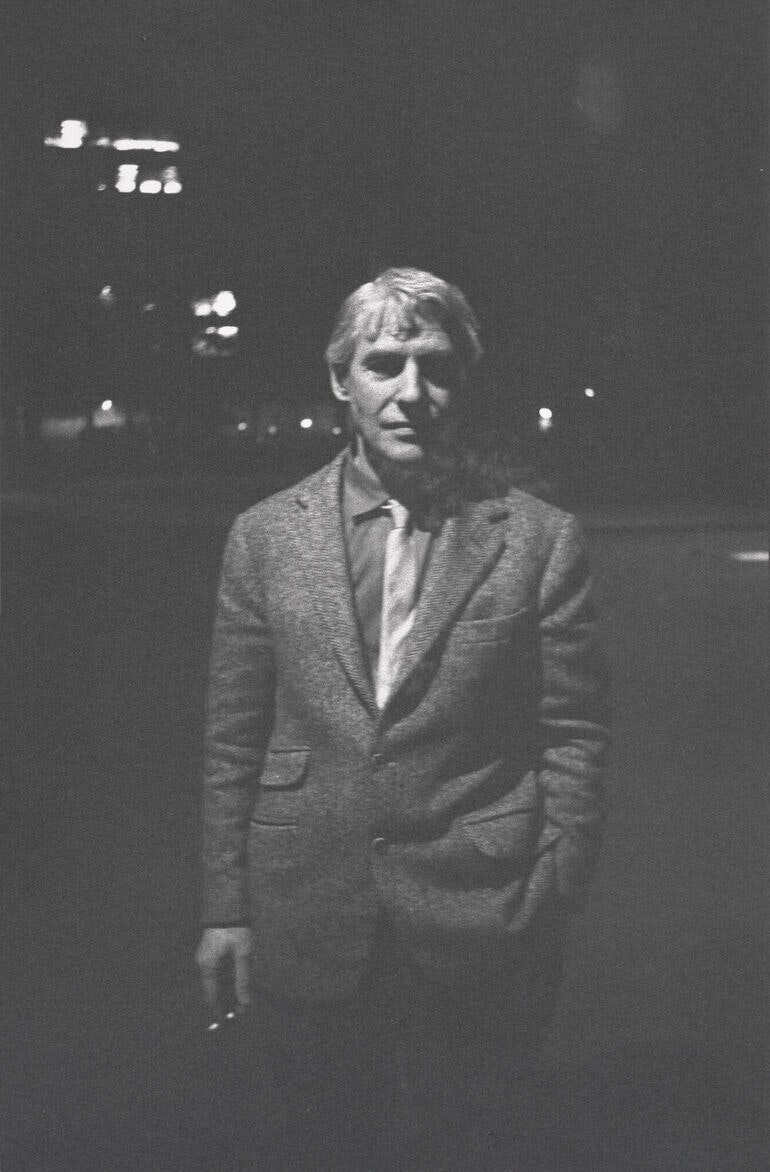
Willem de Kooning, 1957, ca. 1960. Photograph by Robert Frank. Collection Center for Creative Photography, University of Arizona. ©The June Leaf and Robert Frank Foundation
A successful architect, insurance executive, and self-proclaimed “Sunday Painter,” Edward Gallagher, Jr. (1892-1978) was born and raised in Baltimore. Although an easterner, Gallagher had an emotional connection to Arizona for most of his life, having made his first trip in 1915. The terrain, vitality, and culture of the Arizona desert resonated deeply with him and he continued to visit Arizona to work on a dude ranch near Tombstone. He also introduced his own son, Eddie, to Arizona while he was still a boy. Tragically, Eddie passed away in an accident in 1932, just one week shy of his fourteenth birthday.
Channeling his pain and grief into art philanthropy, Gallagher created Edward Gallagher III Memorial Collections at the University of Arizona Museum of Art, the Baltimore Museum of Art, and the Metropolitan Museum of Art as lasting tributes for his only child. Over two decades, the Arizona collection grew to include roughly 200 works of art, including Woman-Ochre, to be enjoyed by future generations.
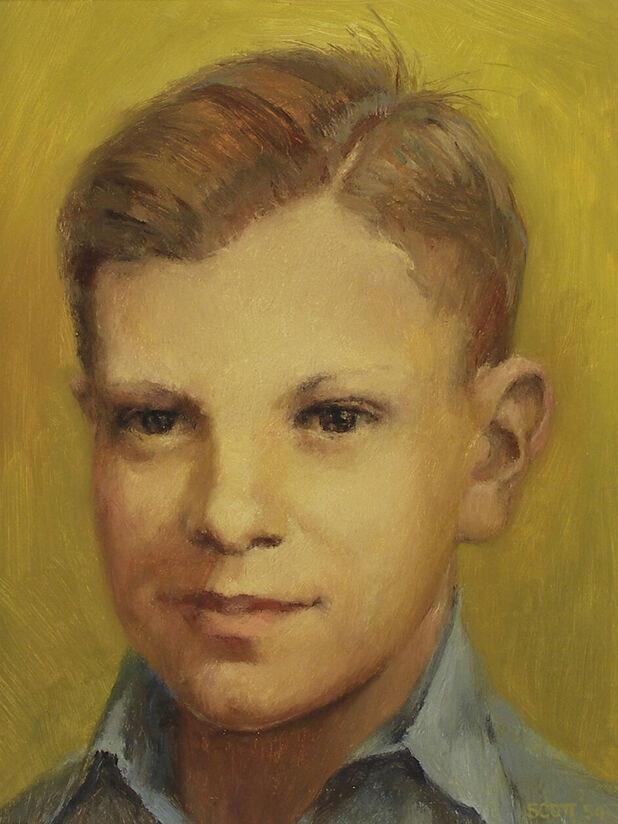
In 1953, the Sidney Janis Gallery opened the exhibition Willem de Kooning: Paintings on the Theme of the Woman, which included approximately twenty paintings, pastels, and drawings of women. The exhibition received mixed reviews, from critics and fellow artists alike. Many were shocked to see a show devoted to figural work when abstraction was rising to the fore of the New York art scene. Jackson Pollock famously quipped, “Bill, you betrayed it. You’re doing the figure, you’re still doing the same goddamn thing.”
Some critics were less focused on the figurative and abstract debate than they were with de Kooning’s representation of women. Art critic Sidney Geist wrote, “In a gesture that parallels a sexual act, he has vented himself with violence on the canvas which is the body of this woman…. He has gone too far, but that is the only place to go.”
De Kooning continued to work on his Woman paintings, completing Woman-Ochre in 1955. Shortly after, the painting was exhibited at the Martha Jackson Gallery in the solo exhibition, Recent Oils by Willem De Kooning. Art critic Kenneth Sawyer wrote, “de Kooning’s ‘Women’ assert a simple truth: they declare the relationship between womankind and the fertility principle of the earth itself.” In other words, these paintings of women are not individual portraits, but rather, are symbolic and represent his view of womanhood or the Female archetype.
In 1957, Woman-Ochre traveled to the Baltimore Museum of Art for the exhibition Contemporary Americans: Selections from the Martha Jackson Gallery. This is likely where Gallagher, Jr. saw the painting and decided to pursue it for the Edward Gallagher III Memorial Collection, donating it to UAMA in 1958.
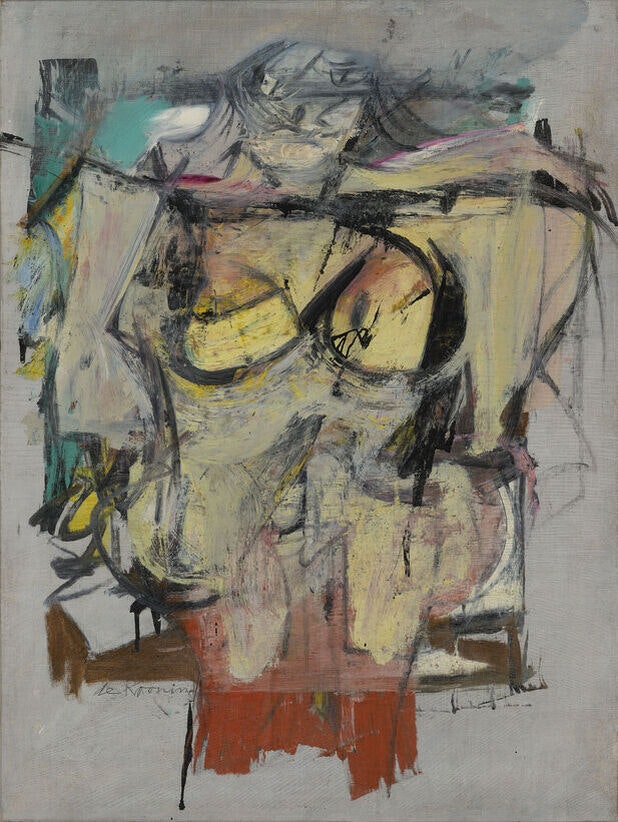
Willem de Kooning, Woman-Ochre, 1954–1955, Oil on canvas, Gift of Edward J. Gallagher, Jr.
It was an almost unimaginable theft given how casually it was carried out, during opening hours and in broad daylight. The day after Thanksgiving, November 29, 1985, a man and woman entered the museum just as it was opening in the morning. As the woman chatted with a security monitor about a painting hung in the stairwell, ostensibly to create a distraction, the man proceeded upstairs. When he returned five to ten minutes later, the couple abruptly left the museum.
The security monitor walked upstairs a few moments later and made a shocking discovery: Woman-Ochre was gone, cut and ripped from its frame.
Immediately after the theft, the University of Arizona Police Department launched an investigation into Woman-Ochre’s disappearance. The Federal Bureau of Investigation was also involved since theft of cultural property is a federal crime. Unfortunately, other than a visual description of the perpetrators and their car, there was little evidence to move the case forward and seemingly no way to track and retrieve the stolen painting. The Edward Gallagher III Memorial Collection that had been designed so that every artwork was integral to the whole, was now incomplete.

In 2015, UAMA commemorated the 30th anniversary of Woman-Ochre’s disappearance by displaying the original empty frame from which the painting was wrenched. In addition, the museum hosted a public event where they recounted the details of the theft and a specialist from the FBI’s Art Crime Team discussed the prevalence of art crime. The event received a substantial amount of press which helped to re-circulate the story in the public sphere.
And then, something remarkable happened. Two years later, on the afternoon of August 3, 2017, antique dealer David van Auker from Silver City, New Mexico called the museum. He and his fellow co-owners of the store Manzanita Ridge, Buck Burns and Rick Johnson, had unknowingly purchased Woman-Ochre from the estate of Jerome and Rita Alter of Cliff, New Mexico. After researching the artist online, they soon realized they were in possession of the stolen painting.
Less than 48 hours later museum staff found themselves in Silver City, laying eyes on Woman-Ochre for the first time. Shortly thereafter, it was transported back to the University of Arizona Museum of Art where conservator Dr. Nancy Odegaard did an assessment of the painting’s condition and a preliminary authentication of the work. Although heavily damaged and in fragile condition, Dr. Odegaard confirmed that the painting was indeed UAMA’s Woman-Ochre.

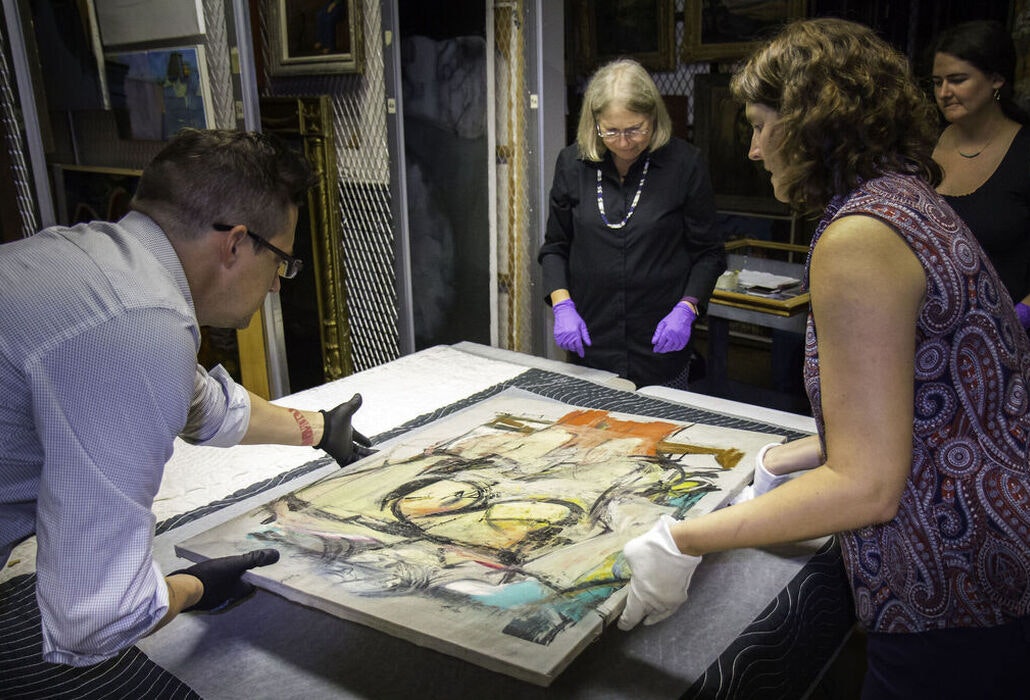
Woman-Ochre was significantly damaged during and after its theft. The violent nature of the theft–which included cutting the painting from its frame, pulling it from its lining canvas, and rolling it up–caused tears, lifting and flaking paint, and overall structural damage. The painting was also subsequently reframed and varnished, likely by the thieves.
In 2019 UAMA sent Woman-Ochre to the Getty Center in Los Angeles where it stayed for three years as it underwent sophisticated technical study and conservation treatment. This multi-step process involved a team of scientists and conservators who worked together to assess the damage and analyze de Kooning’s methods and materials in order to determine a treatment plan for Woman-Ochre.
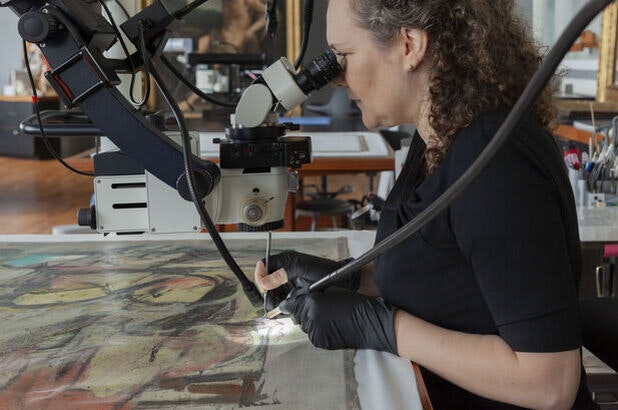
For the first time since its theft in 1985, the public can once again see Willem de Kooning’s Woman-Ochre at the University of Arizona Museum of Art. It returned to Tucson from Los Angeles in Fall 2022 and was met with a historic homecoming including a press conference, screening of The Thief Collector documentary and a “Welcome Home” celebration that served as the opening reception for the Restored: The Return of Woman-Ochre exhibition.
Restored, open from October 2022 through May 2023, documented every chapter of the incredible story that captivated the general public and national media. With never-before-seen archival materials and ephemera, the exhibition attracted record numbers of visitors from around the country and globe. It also engaged classes across campus — including journalism, forensic accounting and criminal justice — and was accompanied by a variety of programming. After the exhibition concluded, Woman-Ochre returned to the wall it was stolen from in what is now known as UAMA’s Manzanita Ridge Gallery — renamed in honor of the owners of Manzanita Ridge Furniture and Antiques, three honest men who found the painting and returned it to the museum

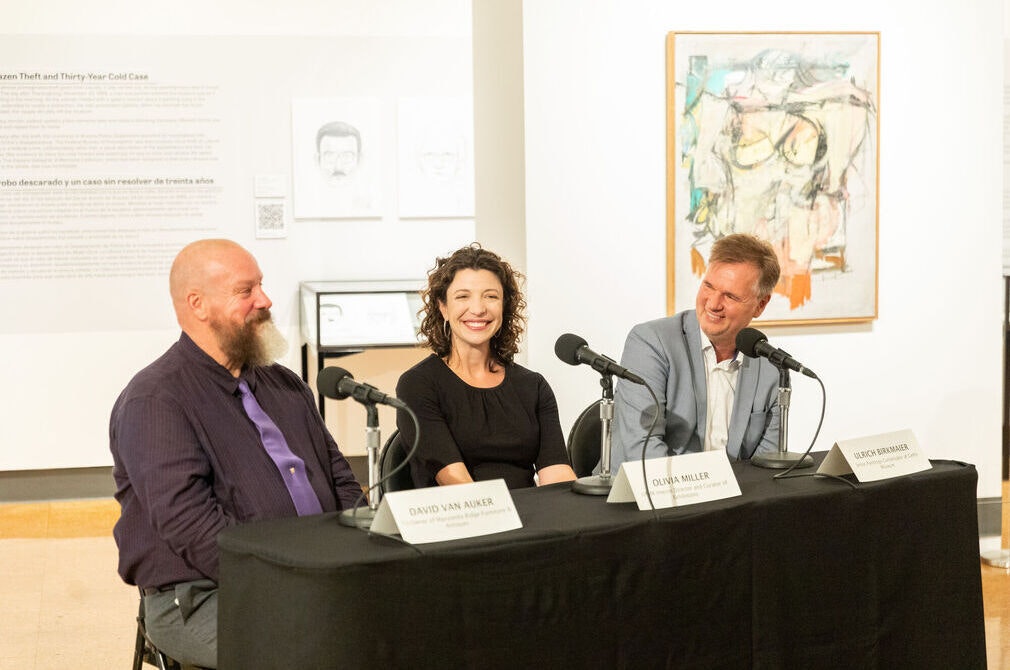
Directed by Allison Otto, the independent documentary The Thief Collector takes a closer look at the circumstances surrounding Woman-Ochre's theft and at the couple who had the painting hanging in their bedroom. It features reenactment scenes filmed inside the museum and interviews with UAMA staff.
After appearing at film festivals around the world, The Thief Collector debuted on Prime UK in March 2023 and garnered coverage in The Guardian. The film became available to Prime audiences in the U.S. in May 2023.
